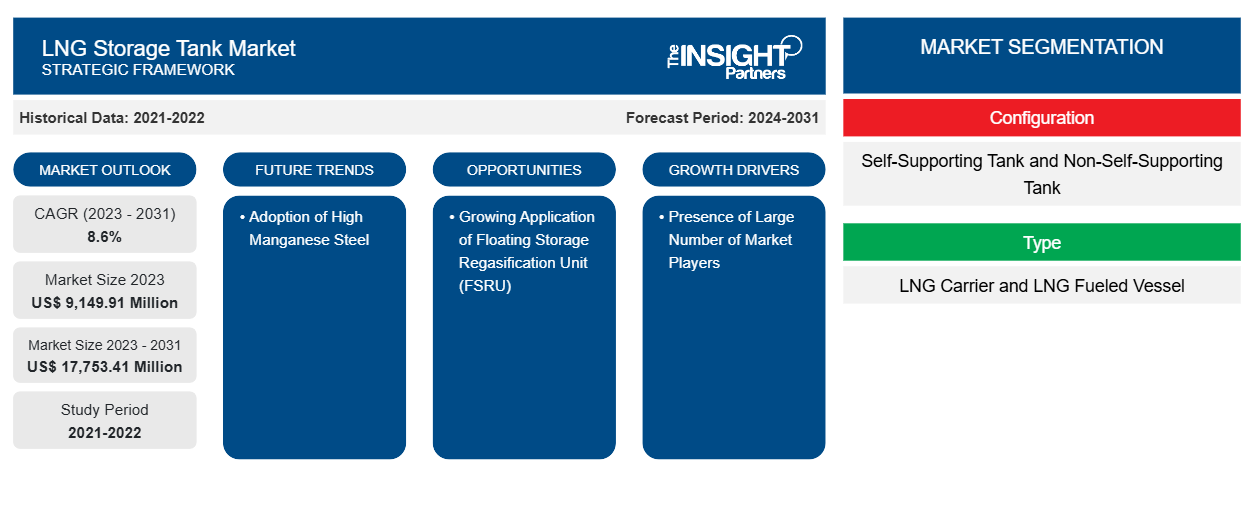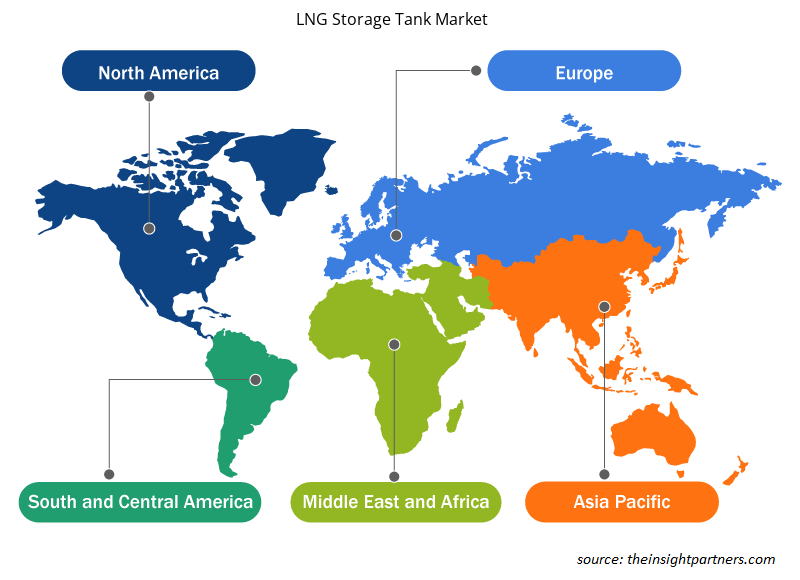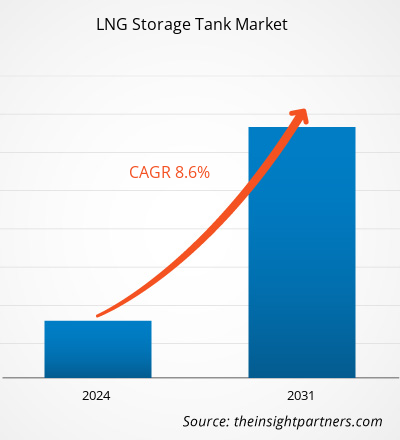The LNG storage tank market size is projected to reach US$ 17,753.41 million by 2031 from US$ 9,149.91 million in 2023. The market is expected to register a CAGR of 8.6% during 2023–2031. The growing number of LNG trades globally is likely to remain a key trend in the market.
LNG Storage Tank Market Analysis
LNG-fueled vessels are gaining attraction in the current scenario owing to the fact that LNG is the cleanest form of any ship and vessel fuel available in the market space. The orderbook of LNG-fuelled vessels continues to grow as the shippers are increasingly emphasizing procuring newly built LNG-fuelled vessels or converting conventional vessels to LNG-fuelled vessels, which is one of the major drivers for the market.
LNG Storage Tank Market Overview
The LNG Storage tanks market primarily comprises key stakeholders, namely raw material suppliers, LNG storage tank manufacturers, regulators/shipping container authorities, and end users. The raw material suppliers associated with the LNG storage tanks offer different materials used for the manufacturing of LNG tanks/carriers offered to the manufacturers. The LNG storage tank manufacturers design, install, engineer, maintenance, and deploy the LNG tanks/carriers to meet the requirements of the end-user. The manufacturers have to adhere to various regulations set by the government before manufacturing these tanks. The LNG storage tank provider essentially possesses the technical expertise to provide an efficient and reliable LNG carrier, and LNG fuelled vessels to the shipping industry. Finally, the end-users, such as shipbuilders and ship owners, install these tanks on the ship and offer reliable LNG trade services.
Customize This Report To Suit Your Requirement
You will get customization on any report - free of charge - including parts of this report, or country-level analysis, Excel Data pack, as well as avail great offers and discounts for start-ups & universities
LNG Storage Tank Market: Strategic Insights

- Get Top Key Market Trends of this report.This FREE sample will include data analysis, ranging from market trends to estimates and forecasts.
You will get customization on any report - free of charge - including parts of this report, or country-level analysis, Excel Data pack, as well as avail great offers and discounts for start-ups & universities
LNG Storage Tank Market: Strategic Insights

- Get Top Key Market Trends of this report.This FREE sample will include data analysis, ranging from market trends to estimates and forecasts.
LNG Storage Tank Market Drivers and Opportunities
The presence of a Large Number of Market Players to Favor Market
The higher number of LNG storage tank suppliers along with end users is one of the critical factors propelling the market growth. Some of the leading LNG storage tank market players globally are Chart Industries, Inc.; McDermott International, Inc.; Corban Energy Group; TransTech Energy LLC; and Maverick Engineering, Inc., among others. In APAC, Air Water Inc., CIMC Enric Holding Ltd., IHI Corporation, are some of the major manufacturers of LNG storage tanks. China holds for the largest sea trade business in the region, holding approximately ~60% of the sea trade business in Asia Pacific. Japanese and South Korean LNG storage tank companioes are also have sufficient order volumes year-on-year, which helps in the growth of the LNG storage tanks market in the Asia Pacifc. Product innovation, design and a strong supply chain are some of the major factors driving the LNG storage tanks market globally.
Acceptance of High Manganese Steel
The insulation material procured by the manufacturers is to cover an outer fire-resistant cladding, that generates a hard outer surface. At present, the LNG storage tank manufacturers are procuring high manganese steel, which is considered a new type of steel, i.e., fabricated by adding 3%–27% of manganese to steel. The high manganese steel does not break at an extremely low temperature, which is as low as -196°C. The high manganese steel is much cheaper compared to conventional steel and helps reduce the material and welding costs. Thus, the growing trend of adopting high-manganese steel for the manufacturing of LNG storage tanks is supporting the market growth.
LNG Storage Tank Market Report Segmentation Analysis
Key segments that contributed to the derivation of the LNG storage tank market analysis are configuration, type, and material.
- Based on the configuration, the LNG storage tank market is divided into a self-supporting tank and a non-self-supporting tank. The non-self-supporting tank segment held a larger market share in 2023.
- Based on the type, the LNG storage tank market is divided into LNG carriers and LNG-fueled vessels. The LNG carrier segment held a larger market share in 2023.
- Based on the material, the LNG storage tank market is divided into stainless steel, aluminum alloy, 9% nickel steel, invar alloy, and c-mn steel. The stainless steel segment held a larger market share in 2023.
LNG Storage Tank Market Share Analysis by Geography
The geographic scope of the LNG Storage Tank market report is mainly divided into five regions: North America, Asia Pacific, Europe, Middle East & Africa, and South & Central America.
The scope of the LNG storage tank market report encompasses North America (the US, Canada, and Mexico), Europe (Russia, the UK, Germany, France, Italy, and the Rest of Europe), Asia Pacific (South Korea, India, Australia, Japan, China, and the Rest of Asia Pacific), the Middle East & Africa (South Africa, Saudi Arabia, the UAE, and the Rest of Middle East & Africa), and South & Central America (Argentina, Brazil, and the Rest of South & Central America). In terms of revenue, Asia Pacific dominated the LNG storage tank market share in 2023. North America is the second-largest contributor to the global LNG storage tank market, followed by Europe.
LNG Storage Tank Market Regional Insights
The regional trends and factors influencing the LNG Storage Tank Market throughout the forecast period have been thoroughly explained by the analysts at Insight Partners. This section also discusses LNG Storage Tank Market segments and geography across North America, Europe, Asia Pacific, Middle East and Africa, and South and Central America.

- Get the Regional Specific Data for LNG Storage Tank Market
LNG Storage Tank Market Report Scope
| Report Attribute | Details |
|---|---|
| Market size in 2023 | US$ 9,149.91 Million |
| Market Size by 2031 | US$ 17,753.41 Million |
| Global CAGR (2023 - 2031) | 8.6% |
| Historical Data | 2021-2022 |
| Forecast period | 2024-2031 |
| Segments Covered |
By Configuration
|
| Regions and Countries Covered | North America
|
| Market leaders and key company profiles |
LNG Storage Tank Market Players Density: Understanding Its Impact on Business Dynamics
The LNG Storage Tank Market is growing rapidly, driven by increasing end-user demand due to factors such as evolving consumer preferences, technological advancements, and greater awareness of the product's benefits. As demand rises, businesses are expanding their offerings, innovating to meet consumer needs, and capitalizing on emerging trends, which further fuels market growth.
Market players density refers to the distribution of firms or companies operating within a particular market or industry. It indicates how many competitors (market players) are present in a given market space relative to its size or total market value.
Major Companies operating in the LNG Storage Tank Market are:
- Air Water Inc.
- Chart Industries
- Inc.
- CIMC Enric Holding Ltd.
- Cryolor (Air Liquide SA)
- IHI Corporation
Disclaimer: The companies listed above are not ranked in any particular order.

- Get the LNG Storage Tank Market top key players overview
LNG Storage Tank Market News and Recent Developments
The LNG Storage Tank Market is evaluated by gathering qualitative and quantitative data post primary and secondary research, which includes important corporate publications, association data, and databases. A few of the developments in the LNG Storage Tank Market are listed below:
- Air Water Inc. has acquired M1 Engineering (M1), which is a major global provider of specialized cryogenic distribution equipment based in Bradford, West Yorkshire (England). (Source: Air Water Inc., Press Release, April 2023)
- CIMC Enric Holdings Limited and its subsidiaries announced that its subsidiary, Zhangjiagang CIMC Sanctum Cryogenic Equipment Co., Ltd. and Shijiazhuang Enric Gas Equipment Co., Ltd., secured over RMB400 million (US$ 55.3 million) new orders for LNG on-vehicle cylinders. (Source CIMC Enric Holdings Limited, Press Release, October 2023)
LNG Storage Tank Market Report Coverage and Deliverables
The “LNG Storage Tank Market Size and Forecast (2021–2031)” report provides a detailed analysis of the market covering below areas:
- LNG storage tank market size and forecast at global, regional, and country levels for all the key market segments covered under the scope
- LNG storage tank market trends as well as market dynamics such as drivers, restraints, and key opportunities
- Detailed PEST and SWOT analysis
- LNG storage tank market analysis covering key market trends, global and regional framework, major players, regulations, and recent market developments
- Industry landscape and competition analysis covering market concentration, heat map analysis, prominent players, and recent developments for the LNG storage tank market
- Detailed company profiles
Frequently Asked Questions
Which region dominated the LNG storage tank market in 2023?
Asia Pacific dominated the LNG storage tank market in 2023.
What are the future trends of the LNG storage tank market?
The growing application of floating storage regasification units (FSRU) is the future trend of the LNG storage tank market.
Which are the leading players operating in the LNG storage tank market?
Air Water Inc., Chart Industries, Inc., CIMC Enric Holding Ltd., Cryolor (Air Liquide SA), IHI Corporation, India Inox Pvt. Ltd., Isisan AS, Linde Plc, McDermott International Inc. are some of the leading players in the market.
What would be the estimated value of the LNG storage tank market by 2031?
US$ 17,753.41 million estimated value of the LNG storage tank market by 2031.
What is the expected CAGR of the LNG storage tank market?
8.6% is the expected CAGR of the LNG storage tank market.
- Historical Analysis (2 Years), Base Year, Forecast (7 Years) with CAGR
- PEST and SWOT Analysis
- Market Size Value / Volume - Global, Regional, Country
- Industry and Competitive Landscape
- Excel Dataset
Testimonials
Reason to Buy
- Informed Decision-Making
- Understanding Market Dynamics
- Competitive Analysis
- Identifying Emerging Markets
- Customer Insights
- Market Forecasts
- Risk Mitigation
- Boosting Operational Efficiency
- Strategic Planning
- Investment Justification
- Tracking Industry Innovations
- Aligning with Regulatory Trends
Yes! We provide a free sample of the report, which includes Report Scope (Table of Contents), report structure, and selected insights to help you assess the value of the full report. Please click on the "Download Sample" button or contact us to receive your copy.
Absolutely — analyst assistance is part of the package. You can connect with our analyst post-purchase to clarify report insights, methodology or discuss how the findings apply to your business needs.
Once your order is successfully placed, you will receive a confirmation email along with your invoice.
• For published reports: You’ll receive access to the report within 4–6 working hours via a secured email sent to your email.
• For upcoming reports: Your order will be recorded as a pre-booking. Our team will share the estimated release date and keep you informed of any updates. As soon as the report is published, it will be delivered to your registered email.
We offer customization options to align the report with your specific objectives. Whether you need deeper insights into a particular region, industry segment, competitor analysis, or data cut, our research team can tailor the report accordingly. Please share your requirements with us, and we’ll be happy to provide a customized proposal or scope.
The report is available in either PDF format or as an Excel dataset, depending on the license you choose.
The PDF version provides the full analysis and visuals in a ready-to-read format. The Excel dataset includes all underlying data tables for easy manipulation and further analysis.
Please review the license options at checkout or contact us to confirm which formats are included with your purchase.
Our payment process is fully secure and PCI-DSS compliant.
We use trusted and encrypted payment gateways to ensure that all transactions are protected with industry-standard SSL encryption. Your payment details are never stored on our servers and are handled securely by certified third-party processors.
You can make your purchase with confidence, knowing your personal and financial information is safe with us.
Yes, we do offer special pricing for bulk purchases.
If you're interested in purchasing multiple reports, we’re happy to provide a customized bundle offer or volume-based discount tailored to your needs. Please contact our sales team with the list of reports you’re considering, and we’ll share a personalized quote.
Yes, absolutely.
Our team is available to help you make an informed decision. Whether you have questions about the report’s scope, methodology, customization options, or which license suits you best, we’re here to assist. Please reach out to us at sales@theinsightpartners.com, and one of our representatives will get in touch promptly.
Yes, a billing invoice will be automatically generated and sent to your registered email upon successful completion of your purchase.
If you need the invoice in a specific format or require additional details (such as company name, GST, or VAT information), feel free to contact us, and we’ll be happy to assist.
Yes, certainly.
If you encounter any difficulties accessing or receiving your report, our support team is ready to assist you. Simply reach out to us via email or live chat with your order information, and we’ll ensure the issue is resolved quickly so you can access your report without interruption.





















 Get Free Sample For
Get Free Sample For